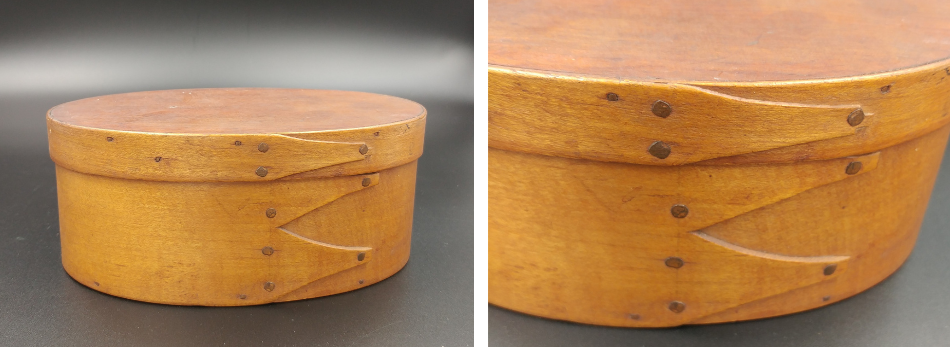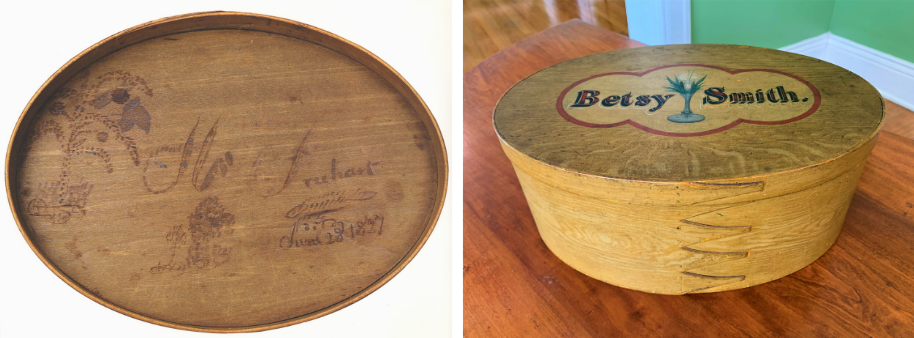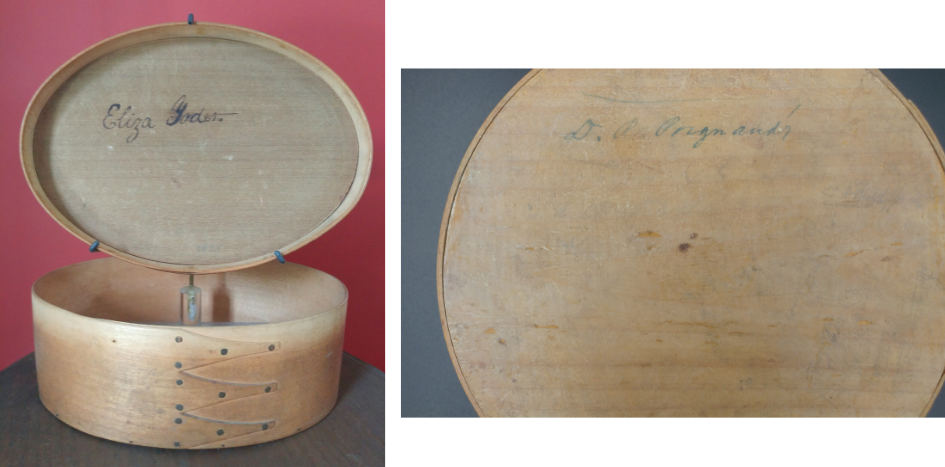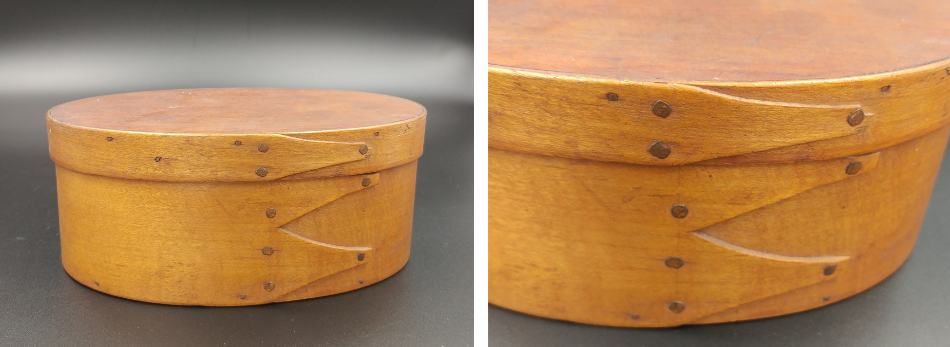
By Tommy Hines, Executive Director, South Union Shaker Village
Pantry boxes, Liberty Hall Historic Site Collections
From frontier times through the early days of the 20th century, wooden boxes were used in great abundance in the kitchens of Kentuckians. There are seven such boxes in the Liberty Hall Historic Site collection. The boxes were produced in a variety of sizes to hold everything from large cheeses to tiny pills.
Most commonly, these boxes were round with solid bottoms and with sides made from a single, thin strip of wood, steamed to be pliable and wrapped around the base. Where the two ends of the strip of wood meet, copper or iron nails were used to secure them together. The transition was either a slightly overlapped straight edge or a v-shaped termination, also known as a finger lap. The top was usually constructed in the same method.
Local carpenters crafted a large majority of this form, commonly known as a “pantry box,” until the advent of factory-made examples.[i] The handmade pantry boxes that survive provide evidence of the disparity of craftsmanship available throughout the Commonwealth. The same is true for those assembled in mass production.
Domestic wooden boxes were mostly round, however, there are examples of oval-shaped boxes as well. While the oval box has become an iconic symbol of Shaker craftsmanship, the Shakers were not the first to make them. With a long history in Europe and early America, oval boxes were made by scores of craftsmen and eventually mass produced, even into the 20th century.[ii] It was the Shakers who “refined and perfected the boxes to such a degree . . . that [they] are easily recognizable when you know what details characterize Shaker manufacture.” [iii] According to June Sprigg and Jim Johnson in “Shaker Woodenware, A Field Guide, Vol. 1,” Shaker boxes can be identified by:
a) a pleasing elliptical shape
b) snugly fitted top and bottom
c) curved “Gothic” arches formed between the finger laps
d) finger laps that are chamfered rather than sawn at a right angle
e) copper or iron tacks that form neatly aligned rows up the side of the box [iv]

Shaker oval boxes were numbered according to size and sometimes labeled from #1 to #11, although larger sizes were often made to meet a customer’s needs. The boxes were also sold in stacks. [v] Before the mid-19th century, Shaker oval boxes were primarily painted. Color was usually applied with the tops on, leaving a band of bare wood visible when the top is removed. This may have been to keep the tops from sticking during humid weather. After ca. 1860, Shaker oval boxes were more often finished with varnish. Two of the boxes in the LHHS pantry box collection appear to have been made by the Shakers and both date to ca. 1870.
As early as the 1790s, the Shakers were making oval boxes in their community at New Lebanon, New York and they were still being crafted at the Sabbathday Lake, Maine Shaker village two hundred years later. The boxes were used by the Shakers within their villages but also manufactured for customers. Production quantities were made at New Lebanon, New York; Enfield and Canterbury, New Hampshire; Alfred and Sabbathday Lake, Maine; and Union Village, Ohio. [vi] The market was brisk for the sale of Shaker boxes for over 100 years. Records from New Lebanon document 3,560 oval boxes manufactured by hand in 1836 alone. [vii]

The Shakers not only used their oval boxes for utilitarian purposes but presented them as gifts. Simple inscriptions are sometimes found on the underside of the wooden lids, signifying a present from a Shaker to a friend from “the world,” or from one Shaker to another. While the Shakers were by tenet supposed to refrain from attaching their names to objects, signatures of ownership are also frequently found on oval boxes. One such oval box, in the South Union Shaker Village collection, has the name “H. Freehart” written on the underside of the lid, along with sketches of trees and foliage. Dated June 23, 1827, the box was probably owned by Hannah Freehart (1804-1894), a woman of color who was a Shaker at South Union for 87 years. There are also examples of elaborately painted “presentation boxes” that were bestowed upon visiting dignitaries, usually from within the faith. On an 1852 journey to the Shaker villages in the northeast, Eldress Betsy Smith of South Union returned to Kentucky with a large grain-painted oval box. On the top of the box was her name in red, black, and white painted letters and between her first and last name a vase of white lilies.

Many of the LHHS boxes are also signed. One pantry box is signed “D.R. Poignand’s.” This refers to David Rozel Poignand (1793-1883). The husband of Eliza Yoder Poignand, David and Eliza lived in Eliza’s childhood home in Spencer County, Kentucky originally called “Beechland” also known as “Vaucluse.” Eliza was Mason Brown’s sister-in-law. Mason married Eliza’s sister Mary Yoder in 1835 and they lived at Liberty Hall. One of the Shaker boxes is signed “Eliza Yoder.” Perhaps Eliza acquired the box prior to her marriage to David in 1847 or it was their daughter’s box, who shared the same name.
It appears that the manufacture of oval boxes in Kentucky’s Shaker villages, Pleasant Hill (1806-1910) and South Union (1807-1922), did not occur. There is no mention of the craft in South Union’s nor in Pleasant Hill’s manuscript records.[viii] However, at the time of the dissolution sale of South Union in September of 1922, there were Shaker-made oval boxes purchased by some of the bidders. It is highly likely that those boxes had been gifts to South Union members from Shakers in other villages. Oval boxes were also found at Pleasant Hill when the restoration began there in the early 1960s.
If the boxes were not produced at either Kentucky village, where did the Yoder/Poignand family acquire the Shaker box in the LHHS collection? The closest source for Shaker oval boxes would have been Union Village, Ohio, near Lebanon. The Shakers made them there for decades, so the boxes were probably available in Cincinnati stores and many other dry goods outlets in the vicinity.

When examining the common pantry box alongside the Shaker oval box, the comparison should be conspicuous. The level of craftsmanship present in the Shaker oval box-making tradition far exceeds that found in the manufacture of most wooden boxes for domestic use, especially those made during the 19th century. Like many of the things created by Shaker hands, it is often noted that the motivation behind their work was that work itself was considered worship. Labor was a “consecrated act” for the Shakers. [ix] It is no wonder that the material culture they created is set apart.
Endnotes
[i] Little, Nina Fletcher, Neat and Tidy: Boxes and Their Contents in Early American Households (2001) Hanover, New Hampshire: Society for the Preservation of New England Antiquities, distributed by University Press of New England, p. 150.
[ii] Sprigg, June and Jim Johnson, Shaker Woodenware: A Field Guide, Volume 1 (1991) Great Barrington, Massachusetts: Berkshire House, p. 26.
[iii] Ibid., p. 26.
[iv] Ibid., pages 26-27.
[v] Rieman, Tim, Shaker: The Art of Craftsmanship (1995) Alexandria, Virginia: Art Services International, p. 48.
[vi] Sprigg, June and Jim Johnson, Shaker Woodenware: A Field Guide, Volume 1 (1991) Great Barrington, Massachusetts: Berkshire House, p. 26.
[vii] Rieman, Tim, Shaker: The Art of Craftsmanship (1995) Alexandria, Virginia: Art Services International, p. 133.
[viii] Consultation with Jacob Glover, Director of Public Programs and Education and Rebecca Soules, Curator of Collections, Shaker Village of Pleasant Hill, June, 2021.
[ix] Goodwillie, Christian, Handled with Care: The Function of Form in Shaker Craft (2006) Pittsfield, Massachusetts: Hancock Shaker Village, p. 5.
